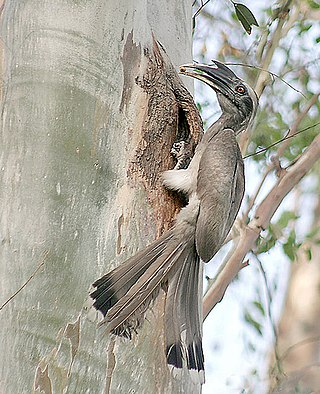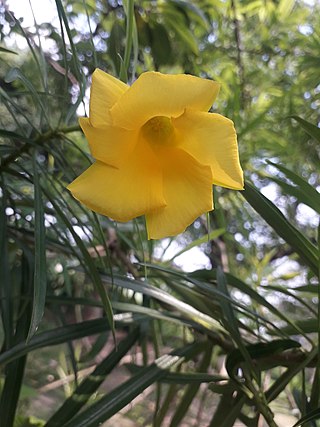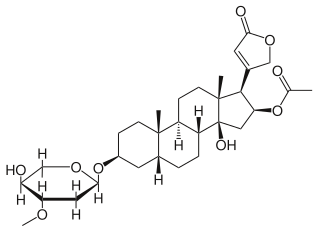
Cardiac glycosides are a class of organic compounds that increase the output force of the heart and decrease its rate of contractions by inhibiting the cellular sodium-potassium ATPase pump. Their beneficial medical uses are as treatments for congestive heart failure and cardiac arrhythmias; however, their relative toxicity prevents them from being widely used. Most commonly found as secondary metabolites in several plants such as foxglove plants, these compounds nevertheless have a diverse range of biochemical effects regarding cardiac cell function and have also been suggested for use in cancer treatment.

Digitalis is a genus of about 20 species of herbaceous perennial plants, shrubs, and biennials, commonly called foxgloves.

Heart failure (HF), also known as congestive heart failure (CHF), is a syndrome, a group of signs and symptoms caused by an impairment of the heart's blood pumping function. Symptoms typically include shortness of breath, excessive fatigue, and leg swelling. The shortness of breath may occur with exertion or while lying down, and may wake people up during the night. Chest pain, including angina, is not usually caused by heart failure, but may occur if the heart failure was caused by a heart attack. The severity of the heart failure is measured by the severity of symptoms during exercise. Other conditions that may have symptoms similar to heart failure include obesity, kidney failure, liver disease, anemia, and thyroid disease.

Digoxin, sold under the brand name Lanoxin among others, is a medication used to treat various heart conditions. Most frequently it is used for atrial fibrillation, atrial flutter, and heart failure. Digoxin is one of the oldest medications used in the field of cardiology. It works by increasing myocardial contractility, increasing stroke volume and blood pressure, reducing heart rate, and somewhat extending the time frame of the contraction. Digoxin is taken by mouth or by injection into a vein. Digoxin has a half life of approximately 36 hours given at average doses in patients with normal renal function. It is excreted mostly unchanged in the urine.

Digitoxin is a cardiac glycoside used for the treatment of heart failure and certain kinds of heart arrhythmia. It is a phytosteroid and is similar in structure and effects to digoxin, though the effects are longer-lasting. Unlike digoxin, which is eliminated from the body via the kidneys, it is eliminated via the liver, and so can be used in patients with poor or erratic kidney function. While several controlled trials have shown digoxin to be effective in a proportion of patients treated for heart failure, the evidence base for digitoxin is not as strong, although it is presumed to be similarly effective.

Apocynaceae is a family of flowering plants that includes trees, shrubs, herbs, stem succulents, and vines, commonly known as the dogbane family, because some taxa were used as dog poison Members of the family are native to the European, Asian, African, Australian, and American tropics or subtropics, with some temperate members. The former family Asclepiadaceae is considered a subfamily of Apocynaceae and contains 348 genera. A list of Apocynaceae genera may be found here.

In chemistry, a glycoside is a molecule in which a sugar is bound to another functional group via a glycosidic bond. Glycosides play numerous important roles in living organisms. Many plants store chemicals in the form of inactive glycosides. These can be activated by enzyme hydrolysis, which causes the sugar part to be broken off, making the chemical available for use. Many such plant glycosides are used as medications. Several species of Heliconius butterfly are capable of incorporating these plant compounds as a form of chemical defense against predators. In animals and humans, poisons are often bound to sugar molecules as part of their elimination from the body.

The brahminy myna or brahminy starling is a member of the starling family of birds. It is usually seen in pairs or small flocks in open habitats on the plains of the Indian subcontinent.

Phytochemistry is the study of phytochemicals, which are chemicals derived from plants. Phytochemists strive to describe the structures of the large number of secondary metabolites found in plants, the functions of these compounds in human and plant biology, and the biosynthesis of these compounds. Plants synthesize phytochemicals for many reasons, including to protect themselves against insect attacks and plant diseases. The compounds found in plants are of many kinds, but most can be grouped into four major biosynthetic classes: alkaloids, phenylpropanoids, polyketides, and terpenoids.

Cerberin is a type of cardiac glycoside, a steroidal class found in the seeds of the dicotyledonous angiosperm genus Cerbera; including the suicide tree and the sea mango. This class includes digitalis-like agents, channel-blockers that as a group have found historic uses as cardiac treatments, but which at higher doses are extremely toxic; in the case of cerberin, consumption of the C. odollam results in poisoning with presenting nausea, vomiting, and abdominal pain, often leading to death. The natural product has been structurally characterized, its toxicity is clear—it is often used as an intentional human poison in third-world countries, and accidental poisonings with fatalities have resulted from individuals even indirectly consuming the agent—but its potentially therapeutic pharmacologic properties are very poorly described.

The Indian gray hornbill is a common hornbill found on the Indian subcontinent. It is mostly arboreal and is commonly sighted in pairs. It has grey feathers all over the body with a light grey or dull white belly. The horn is black or dark grey with a casque extending to the point of curvature of the horn. It is one of the few hornbill species found in urban areas in many cities where they are able to make use of large trees in avenues.

Proscillaridin is a cardiac glycoside, a kind of drug that can be used in the treatment of congestive heart failure and cardiac arrhythmia. It is of the bufanolide type and can be obtained from plants of the genus Scilla and in Drimia maritima.

k-Strophanthidin is a cardenolide found in species of the genus Strophanthus. It is the aglycone of k-strophanthin, an analogue of ouabain. k-strophanthin is found in the ripe seeds of Strophanthus kombé and in the lily Convallaria.

Ibopamine is a sympathomimetic drug, designed as a prodrug of epinine, used in ophthalmology. It induces mydriasis. It also has been investigated for use in the treatment of congestive heart failure.

Gitoformate is a cardiac glycoside, a type of drug that can be used in the treatment of congestive heart failure and cardiac arrhythmia. Produced by Madaus, it is not available in the US, and does not seem to be available in Europe either.

Lanatoside C is a cardiac glycoside, a type of drug that can be used in the treatment of congestive heart failure and cardiac arrhythmia. Lanatoside C can be used orally or by the intravenous route. It is marketed in a number of countries and is also available in generic form. Its main indications are rapid response atrial fibrilation and paroxysmal supraventricular tachycardia, two common types of arrhythmia.

Thevetia is a genus of flowering plants in the family Apocynaceae, first described for modern science as a genus in 1758. It is native to Mexico, Central America, South America, and Cuba. The taxonomy of the genus is controversial, with some authors including Cascabela within Thevetia, while others accept the two genera as separate.

Cascabela thevetia is a poisonous plant native throughout Mexico and in Central America, and cultivated widely as an ornamental. It is a relative of Nerium oleander, giving it a common name yellow oleander.

Oleandrin is a cardiac glycoside found in the poisonous plant oleander. As a main phytochemical of oleander, oleandrin is associated with the toxicity of oleander sap, and has similar properties to digoxin.

Rhein, also known as cassic acid, is a substance in the anthraquinone group obtained from rhubarb. Like all such substances, rhein is a cathartic. Rhein is commonly found as a glycoside such as rhein-8-glucoside or glucorhein. Rhein was first isolated in 1895. It is found in rhubarb species like Rheum undulatum and Rheum palmatum as well as in Cassia reticulata.




















